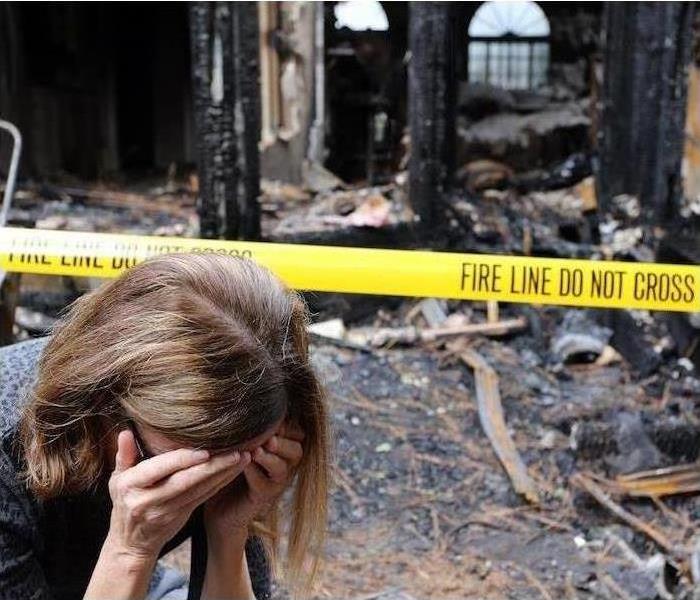What You Should Do After a Fire
3/25/2022 (Permalink)
What You Should Do After a Fire
3/25/2022
After a Fire - Use Caution
While waiting for help to arrive, safety is key:
- Assess whether it’s safe to stay in the house.
- Look out for electrical and “slip and fall” hazards.
- Only attempt activities that are safe for you to perform.
- Wet materials can be VERY heavy. Be careful!
- If safe to enter, and weather permits; open windows and doors to “air out” structure and reduce smoke odors.
What You Should Do After a Fire:
Limit Movement
Limit movement in the home to help prevent cross-contamination such as soot particles being embedded into upholstery and carpets.Wash Plants
Wash houseplants on both sides of the leaves.Cover Traffic Areas
Place clean towels or old linens on rugs, upholstery and carpet traffic areas.Change Filters
Change your HVAC filter.Empty Fridge & Freezer
If electricity is off, empty the freezer and refrigerator and prop open the doors.
What You Should Not Do After a Fire:
Don't Wash Walls or Carpet
Don’t attempt to wash any walls or painted surfaces or shampoo carpet or upholstery without contacting your local SERVPRO as using the inappropriate product or method could lead to additional or irreversible damage.Don't Turn On The Lights
Don’t turn on ceiling fixtures if the ceiling is wet. The wiring may be damaged.Don't Clean Electrical Appliances
Don’t attempt to clean any electrical appliances, including computers or digital devices that may have been close to fire, heat or water without consulting an authorized repair service.Don't Clean Your Clothes
Don’t send garments to an ordinary dry cleaner. Improper cleaning may set smoke odor.Don't Eat Soiled Food
Don’t use any canned or packaged food or beverages that may have been stored near the fire, heat or water.Don't Touch Soot Covered Items
Don’t touch soot-covered items with bare hands. Oils from your skin can cause the soot to permanently stain surfaces.
- How to clean after fire damage?
The majority of cleaning after a fire is working to remove soot residues from the structure and contents of the home or business. We have a specific process we follow, which is tailored to each fire damage situation.
- What is the first thing I should do after a fire?
Experiencing a fire to your home or business can be traumatic and stressful, and knowing what to do after a fire can seem overwhelming. First, contact a local disaster relief agency and your insurance company for immediate assistance, especially if you’ve been displaced. Try to locate any necessary documents you’ll need, like a driver’s license and other records, but don’t enter the structure unless the fire department has deemed it safe for you to do so, first.
- How long will the fire restoration process take?
The timeline for a fire restoration varies greatly, and depends on the severity of fire, smoke and soot damage. The size of the building and the amount of contents also helps determine the length of time for restoration. SERVPRO technicians will complete a full scope of work at the beginning of the project and will provide you with an estimated timeline so you know what to expect.
Steps In Our Fire Restoration Process:
Emergency Contact
The restoration process begins when you call your local SERVPRO location or SERVPRO’s Customer Care Center, both of which are staffed 24 hours a day. Our specialist will ask a series of questions regarding the fire damage event that will help us dispatch the nearest SERVPRO professionals to your location.
Inspection & Fire Damage Assessment
Our professionals will carefully inspect and test adjoining rooms of your property to determine the extent of the fire, smoke and soot damage. This step is crucial in developing a plan of action. We work alongside investigators, insurance companies and the fire marshal to determine the type, degree of and extent of damage to materials and belongings.
Immediate Board-Up & Roof Tarp Service
Fire damage can often compromise windows, walls and roofs. To maintain security and to protect against further damage, SERVPRO can board up missing windows and walls and place tarps on damaged roofs. We also offer debris removal, installation of emergency power and temporary lighting, temporary structural repairs and more.
Water Removal & Drying
If water damage is present, the water removal process will begin almost immediately and removes the majority of the water. We will then use dehumidifiers and air movers to remove the remaining water and complete the drying process.
Removal of Smoke & Soot From All Surfaces
SERVPRO professionals use specialized equipment and techniques to remove smoke and soot from ceilings, walls and other surfaces.
Cleaning & Sanitizing
We remove affected materials while minimizing damage to unaffected or restorable surfaces. Our professionals can inventory non-salvageable property and assist in packing, relocating, cleaning and storing of personal property. We also offer restoration of specialty items such as art, electronics and documents.
Repairs and Construction
After these initial steps, your home may need construction work to get your property back to its preloss condition. The repair step can be minor repairs or rebuilding entire areas of your home. We can simplify the restoration process by handling both the initial damage mitigation and rebuilding the affected areas. Having one qualified company for the entire process can save time and keeps costs low.




 24/7 Emergency Service
24/7 Emergency Service
